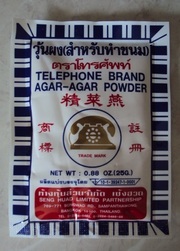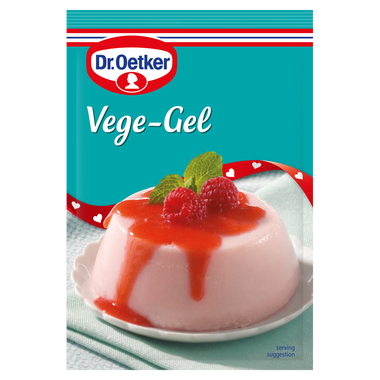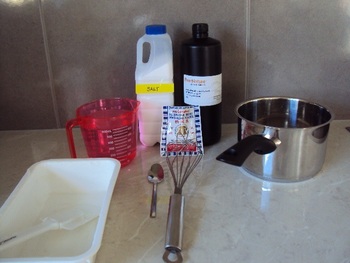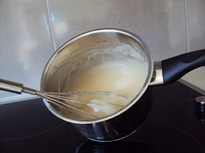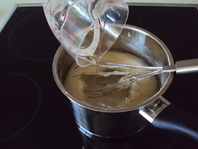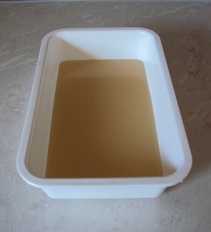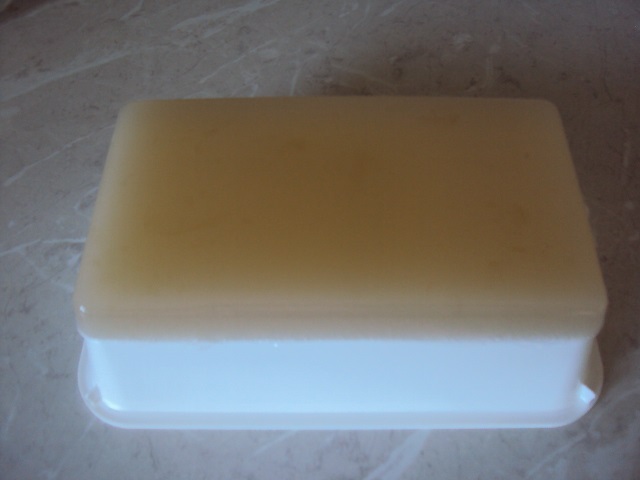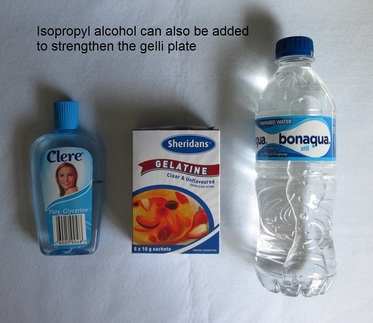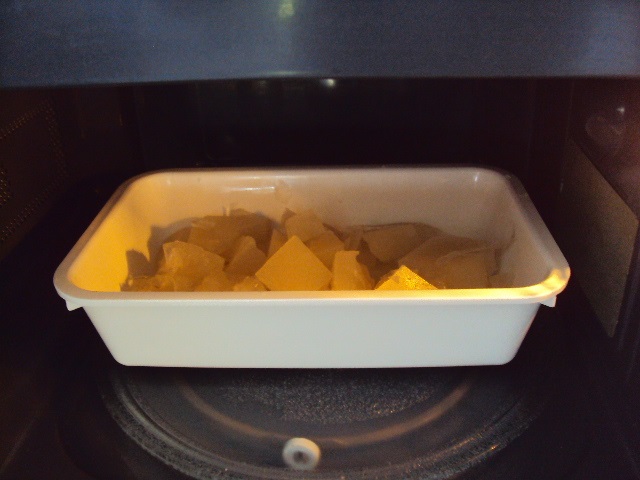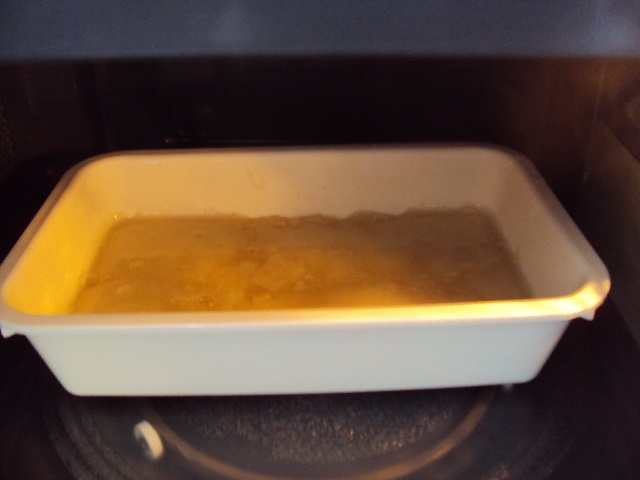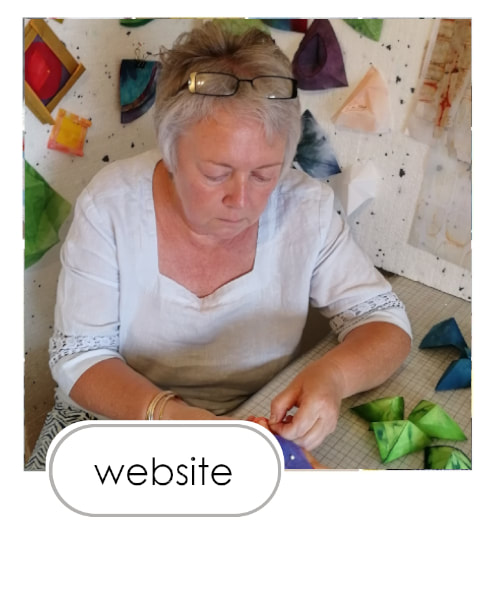So - this is what you do...........................
Re-forming the plates
|
|
Cut or rip the gel plate you wish to recycle into chunks. This helps speed up the melting process. Put it into a microwave bowl and heat for around 1 to 2 minutes on full power (I have a 750W microwave). Keep your eye on it and give it a stir after a minute. If you need to add more time do it in short bursts and watch it at all times. You want the mixture to just bubble up but not over the edges. If it spills over, don't wipe it up - just allow the hot gel to cool then peel it off and stir it back into your molten gel. |
Suppliers you may find handy to know about
|
UK |
Glycerine BP (that means pharmaceutical grade) can a be bought more cheaply in chemists (such as Boots) than in supermarkets where you find edible grade glycerine.
Isopropyl alcohol - also commonly known as 'surgical spirit' or rubbing alohol in the UK. Don't bother with Boots for this one - the thought police have been there and they just give you 'the look' when you ask for it. Last time I tried Superdrug still sell it. |
|
New Zealand |
Gelatine I buy at the supermarket
|
I hope you will find some of this info useful should you wish to try making a gelli plate for yourself. I would love to hear if you do try any of the recipes - and have any feedback . They really are quite fun to use and you can make some very beautiful papers and fabrics using them. I will let you know how my agar agar plates hold up - I don't intend putting them in the fridge - so I will see if they go mouldy or not.
Thanks for reading.
|
Please feel free to share my website or blog with your friends by using the buttons to the right. If you would like to receive an e mail each time I post a new blog, please click here. I promise to never send you junk or give your address to anybody else.
|
|
Typed in a question on google, and found your blog.
Both the Gelli plates and Gel Press gelatin plates are vegan.
I thought it would be terrific to make a home-made vegan version into more unsual sizes and shapes.
So your blog gives one lots of food for thought!
I have been working with kid's fun foam to create plates and stamps. Experimenting without any gelatin plates so far, to see what I could do without them!
It may just be time to play with gelatin plates!
Would love to see what other fabric art you do, and to get notices when you post new things for your blog.
Have a good end of the week!
Best regards,
Dianna
Hi Dianna
Thanks so much for taking the time to look at my blog and then write me a message. It is great to know that others find it interesting.
It was quite a while ago that I wrote that post, and have since made some really large plates - and also a few round ones too. It makes for lots of interesting work to vary things in this way.
I too have been using fun foam - both to make stamps and to press onto the gel plates to remove paint before printing. It is good and useful stuff. I haven't used it as a plate - but why not? Something for me to explore!
The interesting thing that I have found is that the agar agar plate did go mouldy after 6 months, but I just boiled it a lot and let it set and it is as good as new. After 1 year the gelatine based ones are still as good as new. In some ways I think remelting them makes them better as they seem to firm up and become less fragile, although they are pretty robust.
Have fun with it all. I'd love to see what you do.
I'm not sure if you looked at my website to see my other work - but here is a link http://clairepassmore.weebly.com/galleries.html to some of it.
I also have a link where you can sign up to have an email sent to you when I post a new blog post too:
http://weebly.us8.list-manage.com/subscribe?u=4a5af39540f5138630cc7d13b&id=d2d1a4ccfa
Best wishes
Claire
Hello Claire
I've been trying to make a plate with your agar agar recipe. It looks okay but it appears to seep water as you said it might. I've managed to order some locust bean gum and wondered if this will resolve the situation and if you had any idea how much and when i should add it. Will it be okay throwing it in as soon as the agar mix has remelted. Still haven't used the plate I wanted to get the mix right first. Thank you for informative page. I tried searching before for a tried and tested recipe for a gelatine free plate but your site didn't come up at first. If you want the link for the locust gum it's http://www.realfoods.co.uk/shop?search=locust%20gum but that's only in the Uk.
Hi Vin,
Thanks for your message - and I'm glad to know that the agar agar based recipe is working for you - even with the syneresis (weeping) of the plate. In my experience this stops being such a problem after a few days - so I make my plate in advance, then just blot the gel plate a few times in the first week then leave it alone. It doesn't seem to cause any problem when it comes to printing.
Well done on sourcing the locust bean gum. I didn't pursue it in the end as I was able to print with the plates just fine.However, I have read up on the addition of the locust bean gum (also known as carob gum) and it indeed seems that it would work very well to reduce the syneresis. If I were to try it out I would mix it in with the agar agar powder at the start. Here is a link which discussed how to use it. http://www.molecularrecipes.com/hydrocolloid-guide/locust-bean-gum-lbg/.
Given that it is very technical and not directly applicable I would say start of with a little bit of locust bean gum - they talk about up to 1% - which means it probably it isn't going to be a lot. The other thing I have discovered is that remelting the plate in the microwave seems to improve its texture - so you have the flexibility to add more at a later date if the small amount doesn't work first off.
Please do let me know how you get along with it - I'd love to know!
Good luck and best wishes
Claire
Thanks Claire for taking the time to reply. i will leave it for now before adding the gum.Can't wait to have a go with it now.
Thanks for your article.
I had bought agar agar for desserts but didn't like the type of jelly.
It was also not very good at setting with the blackcurrant as I had thought it would be.
So having read this and thought about it I went ahead.
Surprisingly used one and a half paints of glycerine..not much left of my original bottle now!
I made a big plate and it is perfect apart from the few scanned bits from the bottom of my saucepan which got mixed through the final set.
But I am really chuffed with it and it is perfect!
Eventually when I reform it I can filter off the scanned bits!!
I love the sound of making a veggie plate, thankyou so much!
Hi Claire! Delighted to find your blog as I had some sticks of agar in my cupboard for years and couldn’t buy gelli plates here in Dubai. So having used your excellent instructions I’m experimenting now and will let you know the result. 😀
Hello Ruth
How great that you found my blog post about using the agar agar to make printing plates. I hope they were a success and you have finally found a use for your cupboard supplies! The good news is that they don't melt in the heat either, although they do eventually go a bit mouldy, unlike the gelatin type which seem to be able to resist mould.
Once you see some signs of mould just boil it up again - I give it a good few minutes to kill off any germs, then let it set. So far mine has lasted 3 years.
I would love to hear how you get along with them. Good luck!
Best wishes
Claire
Click here if you would like to receive an e mail when I add a new blog post.
OR
Archives
July 2021
June 2021
May 2021
April 2021
March 2021
December 2020
September 2020
August 2020
July 2020
May 2020
February 2020
December 2019
October 2019
September 2019
July 2019
May 2019
March 2019
February 2019
January 2019
December 2018
November 2018
September 2018
August 2018
July 2018
June 2018
May 2018
April 2018
March 2018
February 2018
January 2018
December 2017
November 2017
October 2017
September 2017
July 2017
June 2017
May 2017
April 2017
March 2017
February 2017
January 2017
December 2016
November 2016
October 2016
September 2016
August 2016
July 2016
May 2016
April 2016
March 2016
February 2016
January 2016
December 2015
November 2015
October 2015
September 2015
August 2015
July 2015
June 2015
May 2015
April 2015
March 2015
February 2015
January 2015
December 2014
November 2014
October 2014
September 2014
August 2014
July 2014
June 2014
May 2014
April 2014
March 2014

